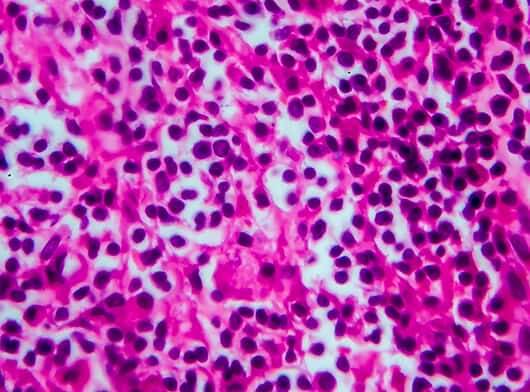- The lymphatic system is a part of our immune system. Clear fluid called lymph flows through the lymphatic vessels and contains infection-fighting white blood cells, known as lymphocytes.
-
The main types of lymphocytes are T-cells and B-cells, which are white blood cells made in the bone marrow. B-cells remain in the bone marrow to mature, while T-cells mature in the thymus, a small organ nestled between the lungs.
- Lymphoma begins when healthy cells in the lymphatic system change and grow out of control. This uncontrolled growth may form a tumour, involve many parts of the lymphatic system, or spread to other parts of the body. B-cells are far more likely than T-cells to mutate and cause cancer such as Hodgkin lymphoma, non-Hodgkin lymphoma or leukaemia.
- The main difference between Hodgkin lymphoma and non-Hodgkin lymphoma is the presence or absence of oversized B-cells called Reed-Sternberg cells. These cells are usually detected during a biopsy and indicate the presence of Hodgkin lymphoma.
- Non-Hodgkin lymphoma (NHL) is a group of cancers of the lymphatic system in which B cells, T cells, or NK cells in the lymphatic system change and grow out of control, sometimes forming a tumour. B-cell lymphoma is the most common type of NHL. T-cell lymphoma is less common, and NK-cell lymphoma is rare. Because of the many types and subtypes of NHL, it is important to know the exact diagnosis to choose the best treatment plan.
- Non-Hodgkin lymphoma that infiltrates sites other than lymph nodes is called extranodal. Some of the most common extranodal sites for the disease are the stomach, Waldeyer ring, central nervous system, lung, bone and skin. In non-Hodgkin lymphoma, the spleen is also considered an extranodal site.
- The main difference between non-Hodgkin lymphoma and Hodgkin lymphoma is the type of lymphocytes affected. Hodgkin lymphoma is marked by oversized B-cells called Reed-Sternberg cells, which are not present in non-Hodgkin lymphoma. Hodgkin lymphoma is usually diagnosed at a younger age, while a majority of non-Hodgkin lymphoma cases are diagnosed in people over 55, with cancer often at a more advanced stage.
- Non-Hodgkin lymphoma is different than leukaemia, another blood cancer. While lymphoma tends to affect the lymph nodes and related tissues, leukaemia affects the blood and bone marrow. Lymphoma, like leukaemia, may appear in the bloodstream as a form of liquid tumour or liquid cancer, but lymphoma is frequently detected after it forms a solid mass of cancerous cells that have built up in a lymph node, gland or organ.
Non-Hodgkin lymphoma:


